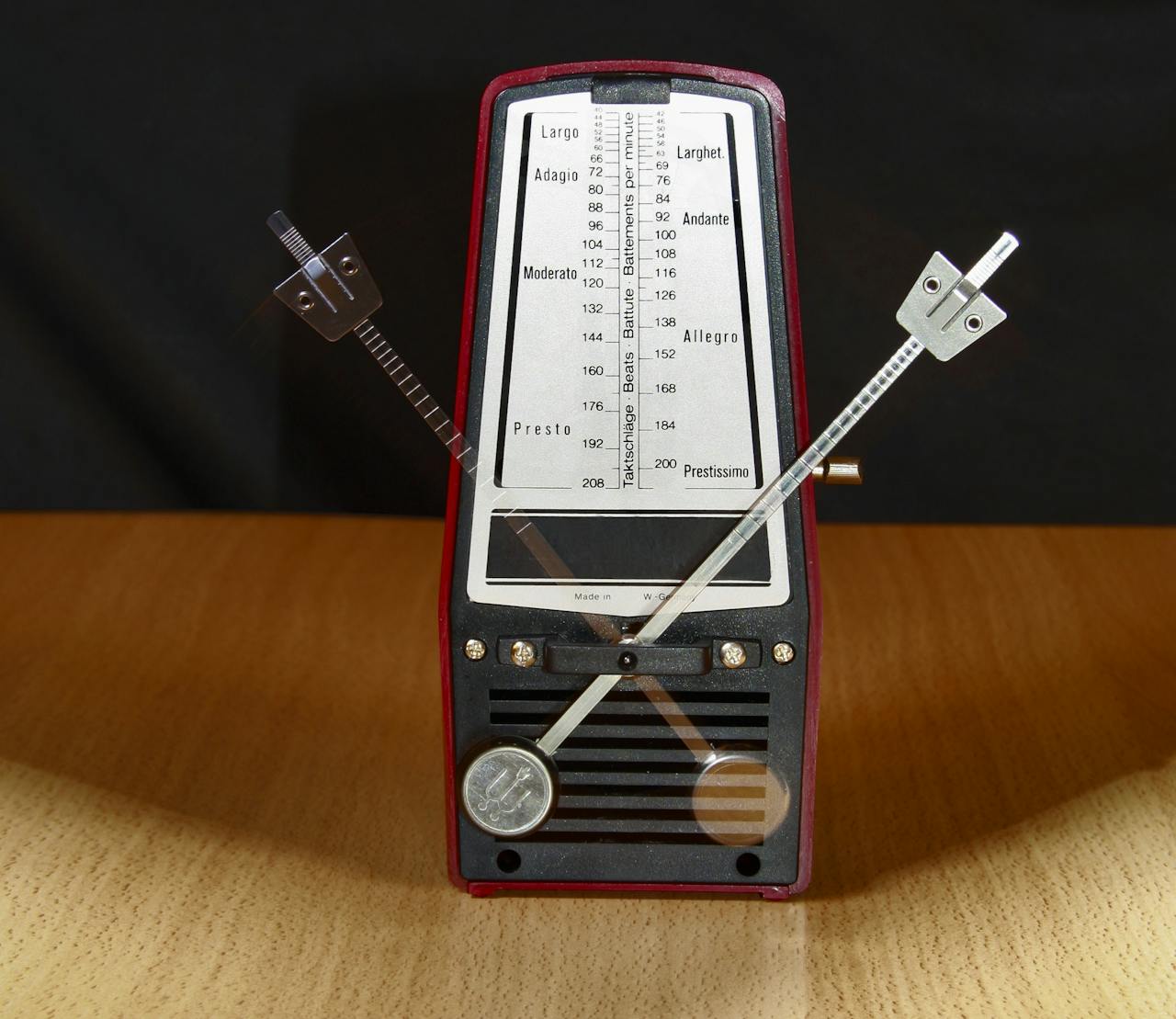If you’ve ever thought, “How long should I practice drums a day?”, you’re not alone. It’s one of the most common questions I hear from both beginners and seasoned players. The good news? You don’t need hours of practice time to make real progress. You just need focus—and a little consistency.
In this post, we’ll look at why short sessions actually work better than long ones for most people. I’ll share a few ideas for how to structure a quick-but-effective drum practice routine, give you real examples you can try today, and cover a few tools that can help you stay motivated along the way.
Whether you’re juggling a full-time job, school, family, or all of the above, there’s a way to make steady progress behind the kit. You just have to make those 15 minutes count.
🎭 The Myth of Long Practice Sessions
When I first started playing, I thought I had to practice for hours every day to get anywhere. I imagined pro drummers locked in their rooms for eight hours straight, just hammering out rudiments and chops. And while there’s some truth to those marathon sessions, most working drummers will tell you it’s not the full picture.
The idea that you need long, drawn-out sessions to improve is something we’ve kind of inherited, especially from music school culture. But here’s the thing: long sessions don’t always equal better results. What matters more is how focused your drum practice actually is.
Spending an hour mindlessly playing can actually set you back, especially if you’re reinforcing bad habits or zoning out halfway through. Quality always beats quantity. A focused 15-minute routine where you're fully locked in can take you much further than a loose hour of noodling around.
It’s not about how long you’re behind the kit—it’s about what you’re doing while you're there. A lot of drummers hit a wall not because they’re not practicing enough, but because they don’t have a plan. And that’s something short, structured sessions can help fix.
🧠 The Science of Short Practice
There’s real science behind why shorter drum practice sessions work so well. Studies on motor learning and muscle memory show that our brains retain skills better when they’re learned in small, focused chunks. That’s especially true for repetitive movements—like drumming.
When you break your practice into short bursts, you’re less likely to burn out or lose focus. You’re also giving your brain time to process what you just did, which helps things stick. Think of it like going to the gym: short, daily workouts usually get better results than pushing yourself too hard once a week.
Short sessions also help you build a daily habit. You don’t need to carve out a huge block of time—just 15 minutes can become part of your routine, like brushing your teeth or checking your phone. And once it becomes a habit, consistency takes over.
That consistency is where real progress lives. It’s not the epic Sunday marathon that moves the needle—it's the little daily moments where you sharpen your timing, clean up your technique, and get more comfortable behind the kit.
So if you’ve ever wondered, how long should I practice drums a day?—start with 15 focused minutes. You’ll be surprised how far it can take you.
⏱️ Building a 15-Minute Drum Practice Routine
So what does a solid 15-minute routine actually look like? You want to pack just enough into that time to stay sharp without overloading yourself. The goal is to make every minute count.
A simple structure is to divide it into three parts: a quick warm-up, a focused skill, and a short wrap-up. For example: 3 minutes of rudiments to get your hands going, 9 minutes working on a specific groove or fill, then 3 minutes of relaxed playing or cooling down. You can also switch it up daily to hit different areas of your drumming.
Here’s one way to rotate it: Monday could be all about rudiments, Tuesday’s for groove and timing, Wednesday’s for fills and creativity. That keeps things interesting and prevents burnout. Plus, you’re covering all the bases over the course of a week.
It also helps to use a metronome—not just for timing, but for setting goals. You might practice a rudiment at 80 bpm on Monday and aim for 85 bpm by Friday. That gives your drum practice direction and a built-in sense of progress.
Keeping it short means you’re more likely to show up and less likely to dread it. And once it becomes part of your day, it doesn’t feel like a chore—it just becomes something you do.
🥁 Practice Session Examples for Every Level
Let’s break this down with real-life examples, whether you’re brand new to drums or have been playing a while.
Beginner (0–6 months):
Start with single strokes for 3 minutes—just getting used to alternating hands cleanly. Then move into a basic rock beat with a kick-snare-hat combo. Wrap up with a simple coordination drill, like adding a hi-hat foot on quarter notes. These baby steps are the foundation of solid drum practice.
Intermediate (6 months–2 years):
Warm up with paradiddles, paying attention to accents. Then spend the bulk of your time playing groove variations—try playing the same beat but shifting the kick around. Wrap it up by playing to a favorite song or recording yourself and listening back.
Advanced (2+ years):
Open with hybrid rudiments like the flam drag or pataflafla. Move into more complex stuff: polyrhythms, ghost note control, or linear phrasing. Then finish off by improvising over a loop or backing track—this keeps your musical instincts sharp and your creativity flowing.
The goal is to keep the practice challenging but doable. If you’re always struggling, you’ll burn out. If it’s too easy, you’ll get bored. A good drum practice routine lives right in that middle zone.
🔁 Staying Consistent and Motivated
The hardest part of drum practice usually isn’t the playing—it’s just showing up. Life gets busy, distractions pop up, and it’s easy to skip a day… then another… and before you know it, your sticks are collecting dust. That’s why consistency matters way more than perfection.
The good news is, keeping a 15-minute daily routine is way easier than trying to carve out an hour here and there. It fits into your day like brushing your teeth or scrolling your phone—something small you just do without overthinking it.
One thing that really helps is picking a regular time to practice. Maybe it’s right after breakfast, or during a lunch break, or before bed. Once you find that window, try to stick with it—even if all you can manage is five minutes that day. The habit is the win.
Another trick is setting tiny, achievable goals. Something like “play paradiddles clean at 90 bpm” or “nail that ghost note groove with no flams.” When you hit those marks, it’s motivating—and it builds real momentum over time.
And if you’re ever feeling stuck or unmotivated, recording yourself can help. Sometimes you don’t realize how far you’ve come until you watch an old clip and think, “Whoa, I used to rush that fill every time.” Small wins add up fast when you keep showing up.

🛠️ Tools to Maximize Your 15 Minutes
You don’t need a studio full of gear to have a solid drum practice session. Just a few smart tools can make a big difference. You could use our web-based Rudiments Top Metronome App.
Practicing with a metronome is one of the simplest ways to level up. It keeps you honest and makes it easy to track progress—whether you’re working on rudiments, grooves, or fills. Plus, using the app regularly helps build your internal clock, which is what separates solid drummers from great ones.
You can also use your phone to record short clips of your practice. It’s like a progress journal, and it gives you a fresh perspective on your playing. Or jot down a few notes after each session in a notebook—what felt good, what was tricky, what to hit next time.
The point is, with the right tools and a little intention, those 15 minutes can go a long way. You don’t need a fancy setup. Just a pad, your sticks, and a solid metronome app, and you’re set.
You don’t need hours in a rehearsal space or a full studio setup to get better at drums. With a little structure and a solid plan, 15 minutes a day can seriously move the needle. Drum practice doesn’t have to feel like a grind—it can be something you look forward to.
By keeping things short, staying consistent, and using tools like the Rudiments Top Metronome App, you’ll start noticing real improvement without burning out. And remember: progress in drumming comes from the little things done daily, not the occasional marathon.
So set a timer, grab your sticks, and show up for just 15 minutes. Your future self—tight, locked in, and way more confident behind the kit—is going to thank you for it.
